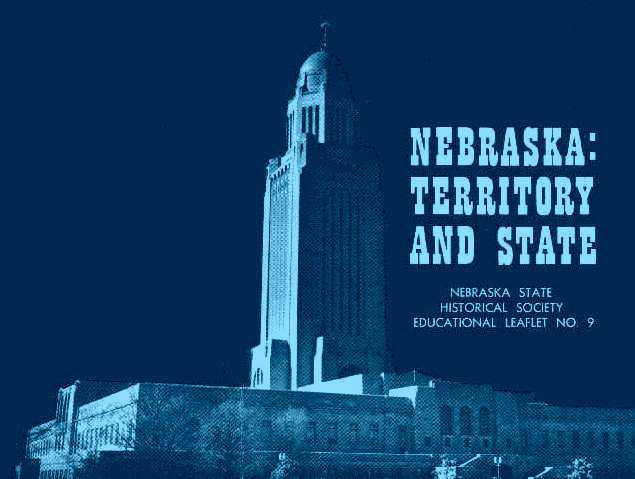

1500 R Street, Lincoln, Nebraska 68508
This reprint made possible by a grant from the
Nebraska Federation of Women's Clubs, Inc. - 1968
Miss Berry is a Research
Associate in the
Library of the Nebraska State Historical
Society
The Nebraska region, lying as it did on the very highway of history, played an important role in the exploration and settlement of the West. The Spanish conquistador Francisco de Coronado contributed a colorful tradition to Nebraska, although it is extremely improbable that he penetrated farther north than a point in present-day Kansas. In 1720 Pedro de Villasur came with a caravan, reputedly to establish a mission and a fort to help hold the country for Spain. But Villasur and most of his companions were massacred along the Platte River and nothing came of his expedition. In 1739 the Mallet brothers, French explorers from Canada, traveled through the Nebraska region seeking a route to Santa Fe.
Nebraska was originally a part of the vast territory acquired through the Louisiana Purchase in 1803. Charged by President Thomas Jefferson with the duty of gathering the first official information about this little-known region, Meriwether Lewis and William Clark made their famous expedition up the Missouri in 1804, establishing campsites and investigating the Nebraska shore. Their most important stop in Nebraska was at a point on the west bank of the Missouri which they named
Other important exploring expeditions, like those of Major Stephen H. Long in 1819-1820 and Lieutenant John C. Fremont in 1842, added to the knowledge of the country, although some of the conclusions drawn were erroneous, as, for example, Long's characterization of the whole plains region as "almost totally unfit for cultivation." Major Long's unfavorable report contributed much toward giving the Plains the name of "The Great American Desert."
An important and picturesque feature of the early history of Nebraska and the West was the fur trade. One of the earliest trading posts in the Nebraska area was Fort Lisa, located some eighteen miles up the Missouri River from present-day Omaha and established about 1813 by Manuel Lisa. Another important post was at Bellevue, which became the first permanent white settlement in Nebraska. Here in 1833 came the first Protestant missionary, Moses Merrill, to work among the Oto and Pawnee Indians. About 1835 the Bellevue post was placed in the charge of Peter A. Sarpy, who became a prominent figure in the later years of the fur trade and the early years of Nebraska Territory.
For more than ten thousand years before the first white explorers arrived, Indians had inhabited the Great Plains. In recent years through archeological surveys and excavations, important discoveries have been made and much information has been amassed concerning the life of these prehistoric Indian groups. The first white men who came to the Nebraska country found there a number of Indian tribes. The Omaha, Ponca, Pawnee, Oto and Missouri were farming groups and had permanent earthlodge villages, while the warlike Dakota or Sioux, the Arapaho and the Cheyenne were nomadic tribes who followed the buffalo herds and lived in the skin tipi.
At the present time, there are approximately 5,500 Indians in Nebraska. The principal Indian groups still living on reservations are the Omaha and Winnebago in Thurston County. Until recently, the Ponca and Santee Sioux in Knox County and a few Iowa in Richardson County also lived on reservations. The trend, however, is away from tribal lands and agency supervision, and Nebraska Indians enjoy the same rights as white citizens. Many are farmers who possess their own land. Within recent years, however, Indians have found employment in Nebraska towns and cities, and groups of Omaha, Winnebago and Ponca now live in Lincoln and Omaha and numerous Dakota
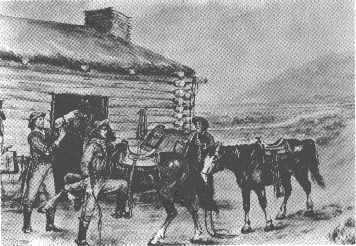
Pony Express relay station. (Photo courtesy of
National Park Service)
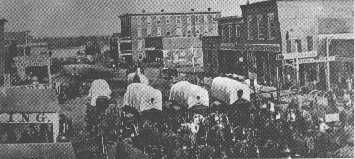
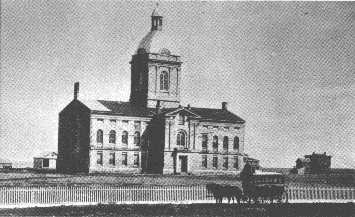
The second State Capitol Building,
Lincoln, 1888.
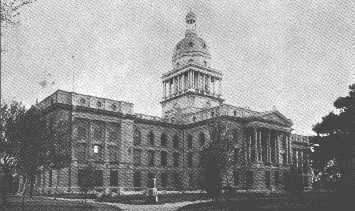
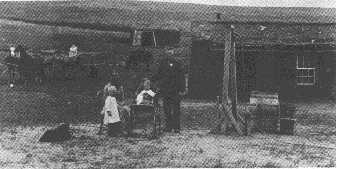
Pioneer farmers often drilled to great depths for
water.
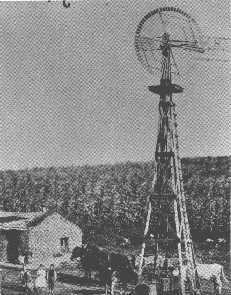
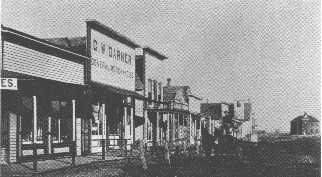
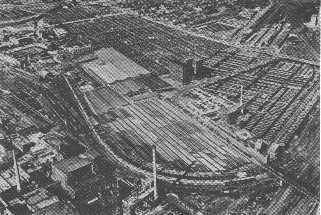
Union Stockyards in Omaha, one of the world's
largest.
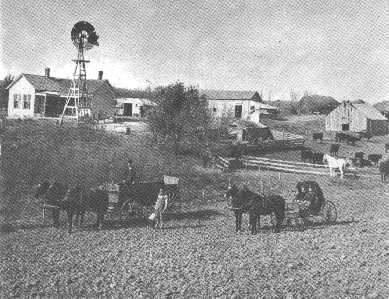
Frame buildings replaced sod
as settlers prospered.
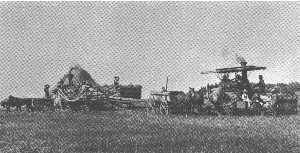
Steam threshing in Dawson
County, Nebraska.
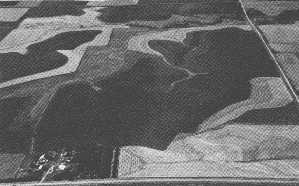
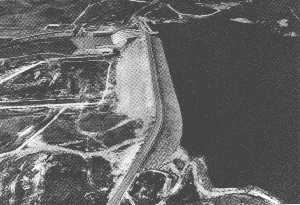
For recreation and conservation, Enders Dam near Imperial.
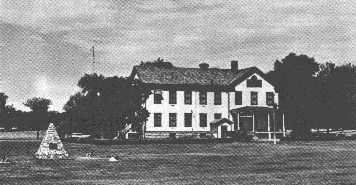
The Headquarters Building at Fort Robinson now
houses a
Branch Museum of the Nebraska State
Historical Society.
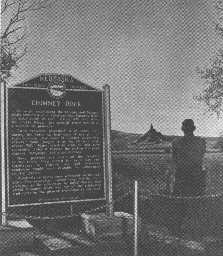
As America expanded westward, military forts were necessary to protect the frontier. Fort Atkinson was the first such post in the trans-Missouri region. Established in 1820 on the historic site of Lewis and Clark's Council Bluff, the fort served as protection for the American fur trade until it was abandoned in 1827. Although it was a military installation, the fort constituted a community, the first white community in the trans-Missouri area. The old post on the Bluffs saw the establishment of the first grist mill, saw mill, blacksmith shop, brickyard and ferry on Nebraska soil. Here also were established the first school and library, and the first extensive farming by white men was carried on in this area.
Other important frontier military posts in Nebraska included Fort Kearny, established in 1848, Fort McPherson, in 1863, Fort Sidney, in 1867 and Fort Robinson, in 1874. All of these forts played a vital part in Indian campaigns and in the protection of emigrants and settlers.
A colorful and important chapter in Nebraska history is the story of the overland trails. Because the Platte Valley formed a natural roadway west, most of the overland traffic passed through Nebraska. The Oregon Trail was the most famous road. Leaving the Missouri River at its great bend near Independence, Missouri, it entered Nebraska at about the line between present Gage and Jefferson counties, followed the valley of the Blue River, crossed the divide to the Platte and continued west along that river. The great Oregon emigration, beginning in 1842, followed this route, as did the bulk of the 1848-1850 gold rush migrants to California. In 1847 the Mormons, starting from Winter Quarters, their temporary settlement at what is now Florence in North Omaha, pioneered a road north of the Platte River. This route, known in history as the Mormon Trail, carried most of the Mormon emigration to Utah as well as a part of the general migration to Oregon and California.
Along these trails, and alternate routes such as the Nebraska City cutoff, went thousands and thousands of men, women and children on their way west. Emigrants, gold seekers, soldiers and freighters passed along the broad valley in every type of conveyance from the handcarts of the Mormons to the huge freighting wagons of Russell, Majors, and Waddell. Through the Platte Valley, too, rode the Pony Express in 1860-1861 to write a glamorous page in the history of transportation in the American West.
The Nebraska area was not open to white settlement until
The capital of the territory was established at Omaha. The territorial period was marked by almost continuous struggle over the permanent capital location. Speculation in town sites and promotion of wildcat banks created a period of boom and bust, but along with these activities went a slow but steady settlement. The passage of the Homestead Act by Congress in 1862 and the building of the Union Pacific Railroad a few years later greatly accelerated settlement. Thousands of Union veterans filed on the public land which the railroads now made accessible, and great numbers of Europeans, induced by the favorable terms offered by railroad company agents, took homesteads in Nebraska. Germans, Czechs and Scandinavians, in particular, stamped the new settlements of Nebraska with the mark of Old World culture. The first homestead application in the nation was filed by Daniel Freeman. He chose a quarter section near Beatrice in Gage County, and his homestead is now the Homestead National Monument.
Settlers coming from the East faced the problem of adaptation to the treeless Plains country. Fuel and water were often scarce. In the absence of wood, settlers burned buffalo chips, cow chips, corn, sunflowers and prairie hay. Water often had to be hauled long distances, and wells were sometimes dug to a depth of several hundred feet before water was reached. Along the Missouri River and in eastern Nebraska, settlers found timber to construct log cabins, but in central and western Nebraska, the sod house built of "Nebraska marble" was the pioneer's solution to the housing problem.
When Nebraska became a state in 1867, a board of three commissioners, appointed for the purpose, chose a site in Lancaster County for the seat of government. A city was laid out and named Lincoln after the Great Emancipator. The subsequent years of statehood witnessed the spread of settlement from the counties along the Missouri to the Colorado and Wyoming borders.
Nebraska's principal resource is its fertile soil, which has made the state one of the most important agricultural areas in the world. Lack of rainfall, however, has been a recurring problem to Nebraska's farmers. Early settlers found that agricultural methods and crops must be modified to suit the semi-arid conditions of the Plains, and that larger areas, necessitating greater
Manufacturing in Nebraska is largely centered around the processing of agricultural products for food and feed. Omaha has one of the world's largest stockyards and is an important meat-packing center. There are large flour mills and feed processing plants within the state, as well as creameries, dairies, beet sugar refineries and canneries. Industrial plants are increasing in Nebraska, and a continuing effort has been made to attract more industry to the state. Within recent years the development of oil and gas wells has resulted in considerable non-agricultural income for many Nebraskans.
In 1934 a unique feature in state government was initiated with the adoption of an amendment to the Nebraska Constitution providing for a unicameral or one-house legislature. The membership of this body was to consist of not less than thirty, nor more than fifty, legislators, to be elected by districts on a non-political ballot and designated as senators. The legislative session of 1935 enacted the necessary statutes to put the amendment into effect, and in January, 1937, the unicameral legislature convened, the first such body in the United States since 1800, and to date, the only one.
Nebraska has contributed a number of noted men and women to the nation and the world. Probably the most widely known Nebraskan was William Jennings Bryan, the Great Commoner. George W. Norris, distinguished Senator and progressive leader, was another well-known Nebraskan. A few others prominent in various fields are: Willa Cather and Mari Sandoz, both distinguished writers; John G. Neihardt, poet and writer of heroic epics of the West; Bess Streeter Aldrich, novelist; John Cassel and Herbert Johnson, cartoonists; Terence Duren and Dwight Kirsch, artists; Howard Hanson, composer and Roscoe Pound, jurist and teacher. in the entertainment world, famous names include: Harold Lloyd, Henry Fonda, Robert Taylor, Dorothy McGuire, Fred Astaire, Marlon Brando, Darryl Zanuck, Johnny Carson and James Coburn.
The Great Plains area provides ideal flying conditions, and
a fairly recent development within Nebraska has been the establishment of airports and national defense installations. Offutt Air Force Base near Omaha, headquarters of the Strategic Air Command, continues the tradition of military installations which began with Fort Atkinson in 1820.
Nebraska's scenic features and recreational facilities have much to offer the permanent resident as well as the passing tourist. The state is exceedingly rich, too, in important historic sites. Better interpretation of these sites and greatly expanded development of recreational potentialities have been planned.These measures should do much toward making the Nebraska of the future not only an outstanding tourist state, but one which offers, in great measure, a better life for its own citizens.
Andreas, A. T., History of Nebraska (Chicago, 1882).
Condra, George E., Geography, Agriculture and Industries of Nebraska (Lincoln: University Publishing Company, 1934). Geography of Nebraska (Lincoln: University Publishing Company, 1927).
Condra, George E., Olson, James C. and Knapp, Royce, The Nebraska Story (Lincoln: University Publishing Company, 1951).
Morton, J. Sterling and Watkins, Albert, History of Nebraska, 3 vols. (Lincoln: North Publishing Company, 1903- 1913).
Nebraska: A Guide to the Cornhusker State, compiled and written by Nebraska Writers Project (New York: Viking Press, 1939).
Nebraska Blue Book, Nebraska Legislative Council, Lincoln. For various years, especially 1915, 1934, 1940 and 1958.
Nebraskaland, Nebraska State Game & Parks Commission, Lincoln.
Nicoll, Bruce H., ed., Nebraska, a Pictorial History (Lincoln: University of Nebraska Press, 1967).
Olson, James C., History of Nebraska (Lincoln: University of Nebraska Press, 1966).
Root, Frank A. and Connelley, William E., The Overland Stage to California (Topeka, 1901).
Sheldon, Addison E., Land Systems and Land Policies in Nebraska (Nebraska State Historical Society Publications, Vol. 22, 1937).
Nebraska: The Land and the People, 3 vols. (Chicago: Lewis Publishing Company, 1931).
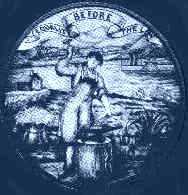
© 1998, 1999, 2000, 2001 for NSHS and NEGenWeb Project by Ted & Carole Miller